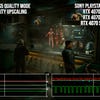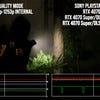Nvidia GeForce RTX 4070 Super review: more frames for less money
The performance and price we should have had at launch?
There are many different ways of looking at the RTX 4070 Super's delivery of price vs performance. Especially with RT factored into the equation, you're looking at a decent performance boosts over the standard RTX 4070, which now looks excessively priced at its new $549 price-point. Meanwhile, in a world where the RTX 4070 Ti cost $799 at launch, you're usually getting 90 to 95 percent of its performance level with a substantial $200 price cut. That's not bad.
However, three-and-a-half years from its launch, the $649 RTX 3080 continues to remind us that value just isn't the same as it was. Yes, the RTX 4070 Super is cheaper, more efficient and has more memory - but ultimately, the performance increase is variable. At worst, it's like a slightly faster RTX 3080. At best, it's up there with RTX 3090... and that's before we factor in DLSS 3 frame generation, which is a very useful feature.
On a broader level, performance that's in line with RTX 3080 Ti or RTX 3090 isn't bad at all for the price-point - but AMD's Radeon RX 7800 XT continues to be an interesting competitor, if you can get it at its $499 MSRP. It lacks the hardware features that make Nvidia so compelling, while its RT performance is way behind. Even so, it continues to deliver the goods in terms of rasterisation and the 16GB complement of framebuffer memory remains a spec point where you can't help but feel Nvidia should be doing better.
While it's obviously useful to base our reviews on the numbers (Mason), I also think we should look at what this class of GPU is doing more holistically. The bottom line is that developers are targeting PlayStation 5 as the foundational basis of the new games they are creating and when you stack up what the 70-class GPUs from Nvidia are delivering, it's highly compelling.
To put some numbers to this, we decided to benchmark the RTX 4070 Super against the PS5 - something's that not altogether easy to do in a world of frame-rate caps and dynamic resolution scaling. In Cyberpunk 2077's Phantom Liberty expansion, we found a spot in the Dogtown market where PS5 couldn't sustain 30fps in its RT mode. In matched settings, 4070 Super offered a 2.21x performance multiplier, rising to 2.3x when FSR2 quality mode was swapped out for its DLSS equivalent. That rose to 3.2x in frame-rate terms when DLSS 3 frame generation kicked in.
Alan Wake 2's quality mode? A 2.17x performance increase in matched settings on the RTX 4070 Super, rising to 2.31x when FSR2 balanced upscaling is again swapped out with the DLSS equivalent. And yes, it's another DLSS 3 game, meaning a 3.1x frame-rate increase over the PS5. In effect, the 4070 Super offers over twice the performance of the PS5 in these games, while DLSS increases both quality and performance.
Results will vary according to the game and the quality of the port, mind you. A Plague Tale: Requiem delivered a 1.96x like-for-like increase, very similar with DLSS quality mode. Frame-gen is available there too, and our test scene offered up a 2.5x increase in frame-rate over the console - so still a big improvement to performance even if you don't consider frame-gen a performance increase.
Naughty Dog/Iron Galaxy's lacklustre port of The Last of Us Part 1 is underwhelming, however, with a mere 36 percent increase (!) in performance over the PS5 operating in fidelity mode. DLSS is the crutch required to offer a game-changing boost to frame-rate - 4K quality mode delivering a 96 percent boost to console performance. Sometimes, not all of the console-level optimisations to make the most of the GPU make their way over to PC - async compute utilisation (or lack of it) apparently causing the problems on this problematic port.
I've discussed console comparisons and yes, optimised settings based on PS5 go a long way from turning what's dubbed a 1440p card into a proper 4K contender. After all, what we're effectively seeing in these comparisons is that 30/40fps quality modes on PlayStation 5 translate into excellent 60fps experiences... or higher. However, we're still talking about circa RTX 3090 level capabilities here, meaning that the RTX 4070 Super will happily run Cyberpunk 2077 in RT Overdrive mode or Alan Wake 2 with path-tracing. This card is still very well-placed in offering up enough raw horsepower to give you access to the absolute cutting-edge - though at that point, optimised settings become even more important.
So, the first Super arrival increases value - and, like the 2019 20-Series refresh, comes across as the kind of pricing we should have had at launch. In terms of competition, AMD's Radeon RX 7800 XT continues to possess more memory, holds up well in rasterisation and obviously costs a lot less - to the point where cutting prices on the non-Super 4070 to match it would have been a good idea. However, in terms of features and overall performance, the 4070 Super is the one to have.
Nvidia GeForce RTX 4070 Super Analysis
- Introduction
- RT benchmarks: Dying Light 2, Cyberpunk 2077, Control
- RT benchmarks: Metro Exodus Enhanced Edition, F1 22
- RT/DLSS/FSR2/DLSS3 benchmarks: Cyberpunk 2077, Dying Light 2, Forza Horizon 5
- Game benchmarks: Control, Cyberpunk 2077, F1 22, Forza Horizon 5
- Game benchmarks: Hitman 3, A Plague Tale: Requiem, Returnal
- Conclusions and recommendations [This Page]




